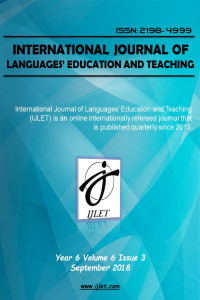Öz
In this study, the place and uses of the interrogative particle "mI" in Tuḥfetü'l-İḫvān which is one of the 15th century works have been examined. Interrogative suffix/postposition in Turkey Turkish has been analysed in terms of its location and uses in the introduction part of the study. This element is considered by the researchers as suffix, postposition, adverb, and exclamation. Essentially, in fact, it is mostly accepted that it is derived from postposition and subsequently becomes an addition. The interrogative particle is one of the widest suffixes among the particles. They are brought to names and verbs. The location of shooting varies according to the person and the code. The interrogative particle whose main function is to establish interrogative sentences contributes to various functions and meanings in terms of its usage and location in the sentence such as questioning, obscurity, suggestion, anger, fear, confusion, ridicule, humiliation, condemnation, contempt, persuasion, challenge, counselling, questioning, doubt, praise, despair, criticism, and defence. In Tuḥfetü'l-İḫvān, this particle has been used in 144 locations. In a sample, unlike the orthography of the era, it is in the form of "mü". This suffix/postposition has been identified with various meanings and functions in the work. Paying attention to the usage of the interrogative sentence following the element which is to be emphasized in particular is striking in the study. It is especially noteworthy that this particle is used as a gerundium. In the beginning, this element, which is only used for question / exclamation, has gained different functions and meanings over time as well as the function of interrogation. Uniformity of expression is changed by altering the position in the sentence, and the sentence is used in various functions ranging from adding various meanings. It can be easily predicted that new functions/usages can be included as a requirement of the vitality of language.
Anahtar Kelimeler
Tuḥfetü’l-İḫvān question in Turkish interrogative suffix/postposition
Kaynakça
- Acarlar, K. (1970). “Mi Ekinin Türlü Kullanımları” Türk Dili, C XXII (277), 358-363.
- Balcı, H. A., Karatay, A., Karatay, S. (2005). İşlevleri Bakımından Kısasü'l-Enbiya ve Nehcü'l-Feradis'te Soru Cümleleri, A.Ü. Türkiyat Araştırmaları Enstitüsü Dergisi S 27, Erzurum.
- Banguoğlu, T. (2011). Türkçenin Grameri, Ankara: TDK Yayınları: 528.
- Baran, B. (2017). Soru İşlevi Gören "mı" Üzerine, Turkish Studies, Volume 12/22.
- Bilgegil, M. K. (1982). Türkçe Dilbilgisi, İstanbul: Dergâh Yayınları.
- Biray, H. (1999). Batı Grubu Türk Yazı Dillerinde İsim, Ankara: TDK Yayınları: 711.
- Eker, S. (2003). Çağdaş Türk Dili, Ankara: Grafiker Yayınları.
- Ergin, M. (1982). Türk Dil Bilgisi, İstanbul: Boğaziçi Yayınları.
- Karaağaç, G. (2016). Türkçenin Dil Bilgisi, Ankara: Akçağ yayınları.
- Korkmaz, Z. (2009) Türkiye Türkçesi Grameri Şekil Bilgisi, Ankara: TDK Yayınları: 827.
Öz
Bu çalışmada, 15. yüzyıl eserlerinden Tuḥfetü'l-İḫvān'da "mI" soru ekinin yeri ve kullanımları incelenmiştir. Türkiye Türkçesinde soru eki/edatı, bunun yeri ve kullanımları giriş kısmında ortaya konmuştur. Bu unsur araştırmacılar tarafından ek (takı), edat, zarf, ünlem olarak değerlendirmektedir. Esasen edat kaynaklı olup sonradan ekleştiği çoğunlukla kabul edilmektedir. Soru eki/edatı, çekim ekleri arasında kapsamı en geniş eklerden biridir. İsimlere ve fiillere getirilir. Çekimde yeri, kişiye ve kipe göre değişiklik gösterir. Asıl işlevi gerçek soru cümleleri kurmak olan soru eki/edatı; kullanıldığı cümleye ve cümledeki yerine göre ifadeye soru, bilinmezlik, seçenek sunma, öfke, korku, şaşkınlık, alay etme, aşağılama, yerme, kınama, küçümseme, ikna etme, meydan okuma, danışma, denetleme, hâl hatır sorma, şüphe, sitem, övgü, çaresizlik, düşündürme, eleştiri, savunma vb. gibi işlevler ve anlamlar katar. Tuḥfetü'l-İḫvān'da soru eki/edatı 144 yerde kullanılmıştır. Bir örnekte döneminin imlasından farklı olarak "mü" şeklindedir. Bu ekin/edatın, eserdeki değişik anlamları ve işlevleri tespit edilmiştir. Eserde özellikle vurgulanmak istenen unsurdan sonra soru ekinin/edatının getirilmesine özen gösterilmesi dikkat çekicidir. Ekin/edatın zarf-fiil işleviyle de kullanılması önemli bir husustur. Başlangıçta belki de sadece soru/ünlem için kullanılan bu unsur, zamanla soru anlamı yanında değişik işlevler ve anlamlar kazanmıştır. Cümledeki yeri değiştirilmek suretiyle ifadedeki tekdüzeliği gidermeden cümleye çeşitli anlam incelikleri katmaya kadar değişik işlevlerde kullanılmaktadır. Dilin canlılığının bir gereği olarak bu işlevlere/kullanımlara yenilerinin de dâhil olabileceği rahatlıkla öngörülebilir.
Anahtar Kelimeler
Kaynakça
- Acarlar, K. (1970). “Mi Ekinin Türlü Kullanımları” Türk Dili, C XXII (277), 358-363.
- Balcı, H. A., Karatay, A., Karatay, S. (2005). İşlevleri Bakımından Kısasü'l-Enbiya ve Nehcü'l-Feradis'te Soru Cümleleri, A.Ü. Türkiyat Araştırmaları Enstitüsü Dergisi S 27, Erzurum.
- Banguoğlu, T. (2011). Türkçenin Grameri, Ankara: TDK Yayınları: 528.
- Baran, B. (2017). Soru İşlevi Gören "mı" Üzerine, Turkish Studies, Volume 12/22.
- Bilgegil, M. K. (1982). Türkçe Dilbilgisi, İstanbul: Dergâh Yayınları.
- Biray, H. (1999). Batı Grubu Türk Yazı Dillerinde İsim, Ankara: TDK Yayınları: 711.
- Eker, S. (2003). Çağdaş Türk Dili, Ankara: Grafiker Yayınları.
- Ergin, M. (1982). Türk Dil Bilgisi, İstanbul: Boğaziçi Yayınları.
- Karaağaç, G. (2016). Türkçenin Dil Bilgisi, Ankara: Akçağ yayınları.
- Korkmaz, Z. (2009) Türkiye Türkçesi Grameri Şekil Bilgisi, Ankara: TDK Yayınları: 827.
Ayrıntılar
| Birincil Dil | Türkçe |
|---|---|
| Konular | Dil Çalışmaları (Diğer), Türk Dili ve Edebiyatı (Diğer) |
| Bölüm | Araştırma Makalesi |
| Yazarlar | |
| Yayımlanma Tarihi | 30 Eylül 2018 |
| Yayımlandığı Sayı | Yıl 2018 Cilt: 6 Sayı: 3 |


